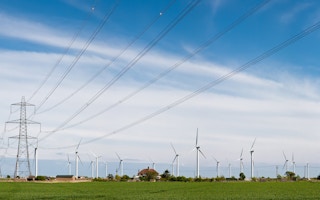The quality of British electricity is falling because unreliable renewable generation is becoming an increasingly large component in the power supply, causing more flickering in households and potentially triggering outages.
Because electricity flows constantly, power grids need to maintain a stable current, known as fault level. And the problem might not be fixed any time soon as the technology to store electricity, and so balance renewable supply, is in its infancy.
Britain’s power grid is balanced around a frequency of 50 Hertz (Hz). Any major deviation above or below this level hits the quality of electric supplies, causing flickering of light bulbs in households and, in the worst case, blackouts.
Maintaining a frequency of 50 Hz has not been a big challenge in the past as Britain’s electricity was produced by a generation of gas, nuclear and coal-fired power stations, controlled by a handful of utilities.
But industry experts warn that the rise of decentralized and unreliable renewable capacity, such as wind, makes it more difficult to maintain a stable frequency, reducing the quality of supplies and potentially collapsing the grid.
The European Network of Transmission System Operators for Electricity (Entsoe) said that a subsidy-fuelled boom in renewable capacity across Europe had coincided in a quality drop of the power frequency.
Entsoe also said that a clash of low renewables with a major capacity outage such as the power link between France and Britain would pose “a severe risk for the system to collapse.”
“As you put more renewables into the system you will lose flexibility and have more flickering and also increase the threat of frequency outages,” said Andrew Jones, Europe’s Managing Director for U.S. based S&C Electric, a global provider of equipment and services for electric power systems.
“All you need is an interconnector or a big station to go out at the same time as winds drop off and you will have a frequency-based outage,” Jones said.
National Grid, which operates Britain’s power transmission system, has also warned of a drop in electricity quality.
“The reduction in fault levels weakens the overall strength of the network which in turn can give rise to quality of supply issues such as large voltage steps, harmonics and flicker,” National Grid said in its latest Electricity Ten Year Statement.
A decade ago, Britain had almost no renewable power capacity installed and instead relied on a mix of gas, coal and nuclear generation.
Today it receives around 10 percent of its electricity from renewable sources, although this figure varies according to changing weather, and by 2020 Britain’s share of installed renewable capacity is expected to reach 20 percent.
Storage would help
Falling frequency is caused by a lack in power production, while rising frequency is triggered by a surplus of power.
Dynamic Demand, a renewable energy consultancy, says that a frequency around 48.5 Hz would result in local blackouts and a frequency of 52 Hz or more would cause power stations to trip and forcefully shut down.
National Grid said it did not have historic data showing the number of serious frequency events, but data from Entsoe shows that continental European countries which have seen a strong rise in renewable capacity in the last 10 years have also seen a sharp rise in the duration and number of frequency events.
To address the problem, most utilities are developing plans to deal with sudden swings in frequency, introducing so-called primary, secondary and tertiary control measures to balance the grid.
These measures range from small scale but fast (within 30 seconds) production adjustments to full-scale emergency backup generators being started up within 15 minutes of an event in order to deal with a sudden drop in frequency as a result of changing renewable generation.
National Grid says that developing storage technology would help stabilize the grid.
“Energy storage technology could play a significant role in the operation of the transmission networks by improving the utilization of renewable generation… particularly with regard to inertia and fast frequency response,” the operator said.
The first such storage technologies are now being tested, but industry experts say much more is needed.
In December 2012, electric distribution company UK Power Networks was awarded 13.2 million pounds ($21.4 million) from Britain’s energy regulator Ofgem to install a 6 megawatt (MW) power storage device to find ways to improve the economics of electrical energy storage.
“We’d need around 2,000 MW of storage capacity installed to show that the economics of power storage work,” said S&C Electric’s Andrew Jones, but added that much more would be needed to properly balance a grid that has 20 percent of its installed capacity coming from volatile renewable sources.

















